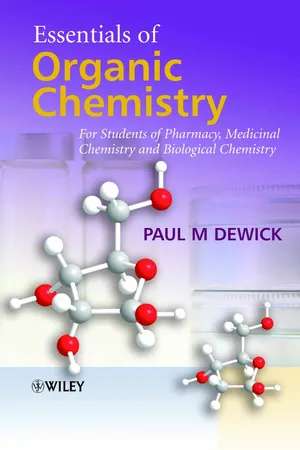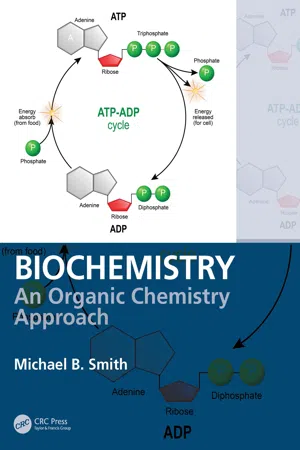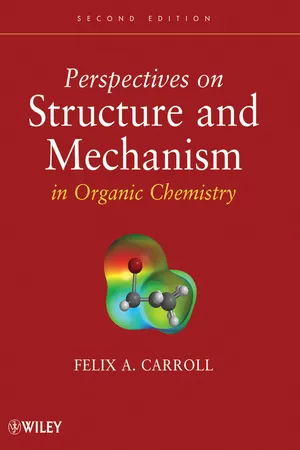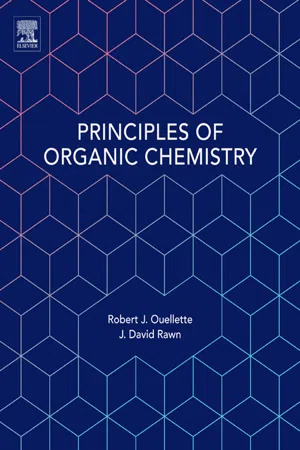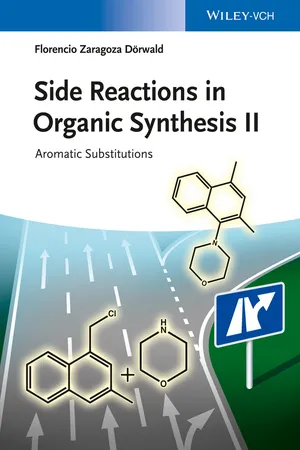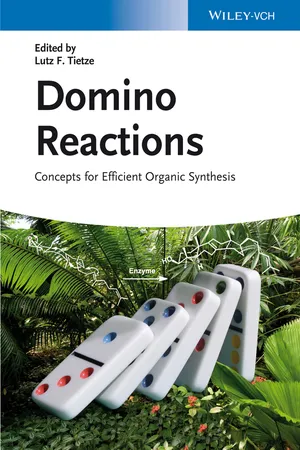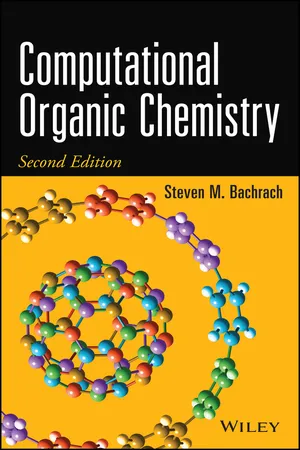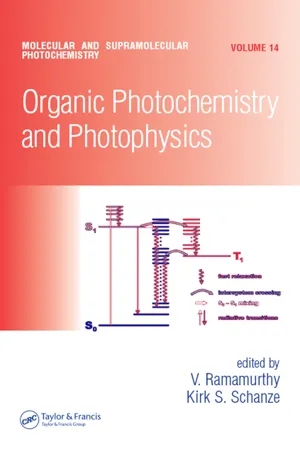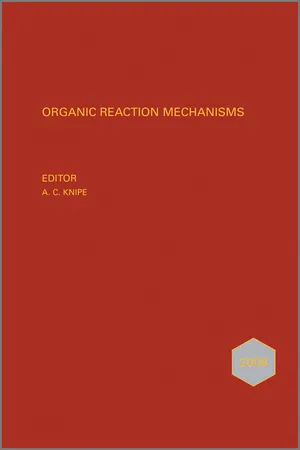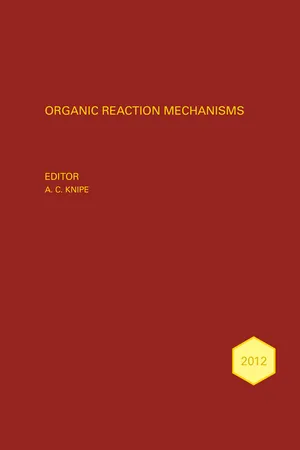Chemistry
Nucleophilic Substitution Reactions
Nucleophilic substitution reactions involve the replacement of a leaving group in a molecule with a nucleophile. This process occurs when a nucleophile attacks an electrophilic center, leading to the formation of a new bond and the displacement of the leaving group. These reactions are important in organic chemistry and are commonly used in the synthesis of various organic compounds.
Written by Perlego with AI-assistance
Related key terms
Related key terms
1 of 4
Related key terms
1 of 3
10 Key excerpts on "Nucleophilic Substitution Reactions"
- eBook - ePub
Essentials of Organic Chemistry
For Students of Pharmacy, Medicinal Chemistry and Biological Chemistry
- Paul M. Dewick(Author)
- 2013(Publication Date)
- Wiley(Publisher)
6
Nucleophilic reactions: nucleophilic substitution
As the term suggests, a substitution reaction is one in which one group is substituted for another. For nucleophilic substitution, the reagent is a suitable nucleophile and it displaces a leaving group. As we study the reactions further, we shall see that mechanistically related competing reactions, eliminations and rearrangements, also need to be considered.6.1 The SN 2 reaction: bimolecular nucleophilic substitution
The abbreviation SN 2 conveys the information ‘substitution–nucleophilic–bimolecular’. The reaction is essentially the displacement of one group, a leaving group, by another group, a nucleophile. It is a bimolecular reaction, since kinetic data indicate that two species are involved in the rate-determining step:where Nu is the nucleophile, RL the substrate containing the leaving group L, and k is the rate constant.In general terms, the reaction can be represented as belowDifferences in electronegativities (see Section 2.7) between carbon and the leaving group atom lead to bond polarity. This confers a partial positive charge on the carbon and facilitates attack of the nucleophile. As the nucleophile electrons are used to make a new bond to the carbon, electrons must be transferred away to a suitable acceptor in order to maintain carbon’s octet. The suitable acceptor is the electronegative leaving group.The nucleophile attacks from the side opposite the leaving group – electrostatic repulsion prevents attack in the region of the leaving group. This results in an inversion process for the other groups on the carbon centre under attack, rather like an umbrella turning inside out in a violent gust of wind. The process is concerted, i.e. the bond to the incoming nucleophile is made at the same time as the bond to the leaving group is being broken. As a consequence, the mechanism involves a high-energy transition state in which both nucleophile and leaving group are partially bonded, the Nu–C–L bonding is linear, and the three groups X, Y, and Z around carbon are in a planar array. This is the natural arrangement to minimize steric interactions if we wish to position five groups around an atom, and will involve three sp 2 orbitals and a p orbital as shown. The p orbital is used for the partial bonding; note that we cannot have five full bonds to a carbon atom. The energy profile for the reaction (Figure 6.1 - eBook - ePub
Biochemistry
An Organic Chemistry Approach
- Michael B. Smith(Author)
- 2020(Publication Date)
- CRC Press(Publisher)
3 Nucleophiles and ElectrophilesAliphatic substitution reactions are early examples of organic chemical reactions in a typical undergraduate organic chemistry course. Such reactions involve the reaction of nucleophilic species with an electrophilic species, and for the most part they follow first-order or second-order kinetics. There are nucleophiles that are prevalent in biochemical reactions, including alcohols, amines, and thiols. Substitution reactions in a typical organic chemistry course involve reactions at carbon that is connected to a heteroatom moiety such as a halogen leaving group. In biochemistry the leaving group is often a phosphonate ester or another biocompatible group. Another type of nucleophilic reaction involves carbonyl compounds, including acyl addition of ketone and aldehyde moieties and acyl substitution reactions of carboxylic acid derivatives.This chapter will briefly review the SN 2 and SN 1 reactions and then describe nucleophiles that are common in biochemical applications and the substitution reactions that are common for these nucleophiles. Nucleophilic reactions require electrophilic species. Electrophiles or electrophilic substrates are common in biochemistry, including phosphonate derivatives, carbonyl compounds and imine compounds. Any discussion of typical nucleophilic reactions also requires an understanding of such electrophilic substrates. The fundamentals of both acyl addition and of acyl substitution reactions will be presented for carbonyl electrophilic centers and the reactions of these electrophilic centers with nucleophiles.3.1 Nucleophiles and Bimolecular Substitution (the SN 2 Reaction)The SN 2 reaction is one of the seminal reactions in a typical undergraduate organic chemistry course. The reaction of 1-bromo-3-methylbutane with sodium iodide (NaI) using acetone as a solvent gave 1-iodo-3-methylbutane, in 66% yield.1 In terms of the structural changes, the iodide ion substitutes for the bromine, producing bromide ion (Br– ). Iodide reacted as a nucleophile in the reaction at Cδ+ of the alkyl bromide, breaking the C—Br bond and transferring the electrons in that bond to bromine. In molecules that contain the C—Br bond, or indeed a C—C bond, where X is a heteroatom-containing group, the carbon will have a δ+ dipole. In other words, the carbon atom is electrophilic, and the substrate that reacts with the nucleophile is called an electrophile. The reaction of a nucleophile with an aliphatic electrophile is formally called nucleophilic aliphatic substitution , illustrated in Figure 3.1 . The displaced atom or group (e.g., chloride), departs (leaves) to become an independent ion. Displacement of chlorine leads to the chloride ion (Cl– ), but the bromide ion, iodide ion, or a sulfonate anion also correlates to X, which is referred to as a leaving group . In many biochemical reactions, the leaving group is a phosphate, —O–PO2 - No longer available |Learn more
- Felix A. Carroll(Author)
- 2011(Publication Date)
- Wiley(Publisher)
CHAPTER 8 Substitution Reactions 8.1 INTRODUCTION In a substitution reaction, an atom or group of atoms (Y) replaces another atom or group of atoms (L) in some molecular entity (RL). In shorthand notation,(8.1)Replacement of one functional group by another may occur either with or without accompanying change in the molecular framework, so R′ need not be identical to R. The general substitution reaction shown in equation 8.1 does not indicate the source of the electrons that are used to make the R′ –Y bond. In nucleophilic substitution, those electrons originate with Y, which is a nucleo-phile (from the Greek, philein, ‘‘to love’’).1 In electrophilic substitution, an electrophile forms a Y–R bond by using both of the electrons in the R–L bond. Leaving groups also are categorized according to the fate of the electrons that bond the leaving group to the molecule. If these electrons depart with the leaving group (as is typically the case in a nucleophilic substitution), then the leaving group is a nucleofuge (equation 8.2 ). If these electrons do not depart with the leaving group (as is typically the case in an electrophilic substitution), then that group is an electrofuge (equation 8.3 ). 2In both equations, the pair of electrons that originally comprises the R–L bond is shown as a bold pair of dots.(8.2)(8.3)It is convenient to categorize reactions with concise descriptive labels. For substitution reactions we often use the notation Sx M, in which the letter S indicates a substitution reaction. The subscript x indicates something of the mechanism, such as N for nucleophilic or E for electrophilic. M usually indicates the molecularity of the reaction, the nature of the reacting species, or additional information.3– 5 The most familiar terms for substitution reactions are SN 1 (for substitution nucleophilic unimolecular6 ), as shown in equation 8.4 - eBook - ePub
- Robert J. Ouellette, J. David Rawn(Authors)
- 2015(Publication Date)
- Elsevier(Publisher)
Most mollusks are protected from predators by a hard shell, so the shell-less sea hare might seem to have little prospect of survival in the face of large carnivores. However, the sea hare converts the halogen-containing compounds in red algae into closely related substances and secretes them in a mucous coating. This coating protects its soft body against carnivorous fish, which are repelled by the compounds.7.2 Nucleophilic Substitution Reactions
In a nucleophilic substitution reaction, the nucleophile donates an electron pair to the electrophilic carbon atom to form a carbon-nucleophile bond. The nucleophile reacts with a haloalkane, which is called the substrate; that is, the compound upon which the reaction occurs. The nucleophile may be either negatively charged, as in the case of OH− , or neutral, as in the case of NH3. These two types of nucleophiles are commonly represented as Nu:− and Nu:, respectively. If the nucleophile is negatively charged, the product has no net charge. If the nucleophile is neutral, the product is positively charged.1.2.The group displaced by the nucleophile is called the leaving group . It has an electron pair that was originally in the C—X bond. Haloalkanes can react with a halide anion, as in the case of the nucleophilic substitution of bromide for iodide in the substrate iodomethane.A similar reaction occurs when the hydroxide ion replaces a halide ion to produce an alcohol. When the oxygen-containing nucleophile is an alkoxide ion (RO− ), the product is an ether.Nucleophilic Substitution Reactions by sulfur-containing nucleophiles, such as hydrogen sulfide ion, HS− , and thiolate ions, RS− , also occur. These reactions yield sulfur analogs of alcohols and ethers— namely, thiols and thioethers (Chapter 8 ).Haloalkanes also react with carbon-containing nucleophiles to form carbon-carbon bonds, which increase the length of the carbon chain. The cyanide ion, C ≡ N− , is a carbon-containing nucleophile. In the reaction shown below it produces a nitrile with the formula RCN, which extends the carbon chain by one carbon atom. Nitriles can be transformed into carboxylic acids (Chapter 12 ) and amines (Chapter 14 ). Carbon-containing nucleophiles derived from alkynes are called alkynide ions. These nucleophiles, the conjugate bases of alkynes (Chapter 4 - eBook - ePub
Side Reactions in Organic Synthesis II
Aromatic Substitutions
- Florencio Zaragoza Dörwald(Author)
- 2014(Publication Date)
- Wiley-VCH(Publisher)
8 Aromatic Nucleophilic Substitutions8.1 General Aspects
Although less important than aromatic electrophilic substitutions, aromatic nucleophilic substitutions are valuable transformations in organic synthesis. Many drugs, agrochemicals, and other structurally complex compounds comprise aromatic nucleophilic substitutions in their industrial syntheses. Numerous reviews have been published [1–4].8.1.1 Mechanisms
Aromatic nucleophilic substitutions can proceed by an addition–elimination mechanism (SN Ar), by an abstraction–addition mechanism (SN 1), via radicals (SRN 1), or via intermediate formation of an aryne (Scheme 8.1 ). The first mechanism is predominant for electron-deficient arenes or heteroarenes capable of delocalizing a negative charge to electronegative atoms. Electron-withdrawing groups in the ortho or para position to the leaving group enhance the rate of SN Ar reactions, whereas electron-donating groups inhibit them. Particularly powerful rate-enhancing groups are diazonium, iminium, nitroso, and nitro groups.Mechanisms of aromatic nucleophilic substitution.Scheme 8.1Naphthyl derivatives undergo SN Ar reactions particularly readily (Scheme 8.2 ) because the dearomatization of naphthalenes requires less energy than that of monocyclic arenes (only one of the two rings of naphthalene is fully aromatic) [5, 6]. 2-Nitronaphthalenes, for instance, behave chemically more as nitroalkenes than as nitroarenes [7].SN Ar reaction at naphthalenes [6, 8, 9].Scheme 8.28.1.2 Regioselectivity
Because the addition of a nucleophile to an electron-deficient arene is reversible, smooth substitutions will occur only at arenes with good leaving groups. For SN Ar reactions, good leaving groups include fluoride, nitrite, sulfonates, the remaining halides, and sulfinates. In the presence of oxidants, hydride may also be a suitable leaving group. The precise ranking of leaving groups also depends on the solvent (solvation of the nucleophile, the Meisenheimer complex, and the leaving group) and on the nucleophile (hydrogen bonding in the Meisenheimer complex) [10–12]. The amino group, for instance, is a poor leaving group in aprotic solvents, but is easier to displace than chloride by hydroxide in water as solvent (Scheme 8.3 ). 6-(Alkylsulfonyl)purines react faster with MeOH/DBU (1,8-diazabicyclo[5.4.0]undec-5-ene) than 6-iodopurines, but more slowly with aniline than 6-iodopurines [13]. A further example of solvent effects in aromatic nucleophilic substitutions is given in Scheme 8.4 - eBook - ePub
Domino Reactions
Concepts for Efficient Organic Synthesis
- Lutz F. Tietze(Author)
- 2013(Publication Date)
- Wiley-VCH(Publisher)
Chapter 4
Domino Reactions Initiated by Nucleophilic Substitution
Hiriyakkanavar Ila, Anand Acharya, and Saravanan PeruncheralathanDomino reactions are defined as two or more bond forming transformations under identical reaction conditions, in which the latter transformations take place at the functionalities formed in the former bond forming reactions. Introduction of the domino concept in organic chemistry has greatly improved the efficiency of syntheses, since it not only allows the synthesis of complex compounds from simple substrates in a short way, but has also ecological and economic advantages, minimizing waste and saving labor, as well as our resources [1].In this chapter, the class of domino reactions that are initiated by a nucleophilic substitution, as the first step, are highlighted. These reactions are classified as anionic processes, independently of whether a carbocation is the intermediate as the second substrate (e.g., SN 1 reaction) [1b]. The primary step in this process is the attack of a nucleophilic species, either an anion (e.g., a carbanion, an enolate, alkoxide, or thiolate) or a “pseudo” anion, as an uncharged nucleophile (e.g., an amine or an alcohol) on to an electrophilic center bearing a leaving group. A bond formation takes place with the creation of a new “real” or “pseudo-anionic” functionality, which can undergo further transformations, by being trapped by an electrophilic center present in the molecule (conjugated enone, aldehyde, epoxide, etc.). The sequence can then be terminated either by the addition of a proton or by the elimination of an X group.In the first part of the chapter, we have covered mostly those reactions, initiated by SN 2 type nucleophilic substitution, followed by a Michael reaction on a α,β-unsaturated ketone moiety, present in the intermediate adduct (SN /Michael). A few examples of the reactions with carbonyl compounds and alkyl halides (twofold SN - eBook - ePub
- Steven M. Bachrach(Author)
- 2014(Publication Date)
- Wiley(Publisher)
Chapter 6 Organic Reactions of Anions This chapter presents computational studies of organic reactions that involve anions. These reactions are usually not grouped together in textbooks. However, these reactions are fundamentally variations on a theme. Anions, acting as nucleophiles, can attack sp 3 carbon atoms; we call these as Nucleophilic Substitution Reactions that follow either the S N 1 or S N 2 mechanism. Reactions where the nucleophile attacks sp 2 or sp carbon atoms are addition reactions. The 1,2- and 1,4-addition reactions follow the classic addition mechanism, where the nucleophile adds first followed by the addition of an electrophile. Other nucleophilic reactions at carbonyl compounds, especially carboxylic acid derivatives, follow the addition–elimination pathway. In a sense, these reaction mechanisms differ simply in the timing of the critical steps: the formation of the new C-nucleophile bond and the cleavage of a carbon-leaving group (C-LG) bond. In the S N 1 mechanism, cleavage occurs prior to bond formation. The opposite order characterizes the addition–elimination mechanism—bond formation precedes bond breaking. Lastly, the two bond changes occur together in one step in the S N 2 mechanism. In this chapter, we present the contributions of computational chemistry toward understanding the mechanism and chemistry for three reactions involving nucleophilic attack. The S N 2 reaction, with emphasis on the gas versus solution phase, is presented first. Next, we describe the critical contribution that computational chemists made in developing the theory of asymmetric induction at carbonyl and vinyl compounds - eBook - ePub
- V. Ramamurthy, Kirk S. Schanze(Authors)
- 2005(Publication Date)
- CRC Press(Publisher)
4 PhotoNucleophilic Substitution ReactionsMaurizio Fagnoni and Angelo Albini
CONTENTS 4.1 Introduction 4.2 Mechanism 4.3 Formation of a C-C or Other C-IV Group Elements Bond4.3.1 Alkylation of Aryl Halides via the SN 1 Path4.3.2 Alkylation of Aryl Halides via the SRN 1 Path4.3.3 Alkylation of Aryl Nitriles 4.3.4 Cyanation and Carboxylation 4.3.5 Formation of a C-Si Bond 4.3.6 Formation of a C-Sn Bond 4.4 Formation of a C-V Group Elements Bond 4.4.1 Formation of Amines and Imines 4.4.2 Formation of Nitro Compounds 4.4.3 Formation of a C-P Bond 4.4.4 Formation of a C-As and C-Sb Bond 4.5 Formation of a C-VI Group Elements Bond, Except Oxygen 4.5.1 Formation of a C-S Bond 4.5.2 Formation of a C-Se or C-Te Bond 4.6 Formation of a C-Halogen Bond 4.7 Formation of a C-O Bond 4.8 Synthetic Significance of Photonucleophilic Substitutions4.1 INTRODUCTION
Nucleophilic Substitution Reactions form a significant chapter in the photochemistry of aromatics. Interest in the topic started with the observation in Havinga laboratory in 1956 that the hydrolysis of nitrophenyl phosphates and sulfates, not occurring to a significant extent at room temperature, was much accelerated by (room) light and actually occurred smoothly under irradiation, in particular in the case of the meta isomers [1 ]. A striking point in this reaction is the “meta activation” by the nitro group, in contrast with the ortho-para activation characteristic of thermal nucleophilic substitutions. Along with the opposite stereochemical course of thermal and photochemical cyclization reactions in Vitamin D derivatives, reported shortly afterwards by the same group [2 ], this was one of the key observations evidencing the different behavior of excited states vs. ground states and gave impetus to the development of organic photochemistry and its rationalization in the following years (see, e.g., Refs. 3 ,4 ,5 - eBook - ePub
Organic Reaction Mechanisms 2008
An annual survey covering the literature dated January to December 2008
- A. C. Knipe, A. C. Knipe(Authors)
- 2011(Publication Date)
- Wiley(Publisher)
CHAPTER 8 Nucleophilic Aliphatic Substitution A. C. KNIPE School of Biomedical Sciences, University of Ulster, ColeraineCarbocation ReactionsCarbocation ReactionsS N Reactions Forming C–C Bonds Allyl and Vinyl Systems Small-ring Systems S N Reactions Forming C–Y Bonds Allyl and Vinyl Systems Small-ring SystemsIntramolecular SubstitutionAnchimeric AssistanceNucleophilic Attack at Elements Other than CarbonMedium EffectsMicelles and Phase-transfer CatalysisStructural EffectsTheoretical StudiesMiscellaneous Kinetic StudiesOther StudiesReferencesData on the influence of neutral salts on the rates of unimolecular heterolyses of organic substrates, obtained mainly by the verdazyl method, have been summarized and reviewed with the assumption that heterolysis takes place with consecutive formation of four ion pairs (CIP, CSIP, SIP, and SSIP), ranging from contact to solvent separated.1 The Verdazyl method has also been used to investigate the nature of solvation effects and mechanism of heterolysis of the following t -halides in 19–44 solvents: t -BuX (X = Cl, Br, I), 1-X-l-methyl-cyclopentane and -cyclohexane (X = Cl, Br), 2-chloro-2-phenylpropane, 1-iodoadamantane, and 2-bromo-2-methyladamantane; multiparameter LFER equations were used to correlate the effects.2 - eBook - ePub
Organic Reaction Mechanisms 2012
An annual survey covering the literature dated January to December 2012
- A. C. Knipe, A. C. Knipe(Authors)
- 2015(Publication Date)
- Wiley(Publisher)
Chapter 7 Nucleophilic Aliphatic Substitution K. C. WestawayDepartment of Chemistry and Biochemistry, Laurentian University, Sudbury, Ontario, Canada- Reactions Forming C–C Bonds
- Allylic Substitutions
- Vinylic Substitutions
- Reactions of Cyclic Ethers
- Aziridines and Other Small Ring Substitution Reactions
- Studies Using Kinetic Isotope Effects
- Nucleophilic Substitution on Elements Other than Carbon
- Gas Phase Substitution Reactions
- Medium Effects/Solvent Effects
- Structural Effects
- Theoretical Studies
- Miscellaneous Kinetic and Product Studies
- Acknowledgement
- References
Reactions Forming C–C Bonds
Two reviews of reactions forming C–C bonds have been published. In one review, the SN reactions between carbon nucleophiles and bicyclic oxazines giving highly substituted ring systems with multiple stereocentres are covered.1 The regio- and stereo-selective reactions on the 2.2.1- and 2.2.2-cycloadducts are emphasized. The second review covers the mechanistic studies investigating the C–C bond-forming Negishi reaction.2Several SN reactions forming C–C bonds are catalysed by copper compounds. For instance, the alkylation of 1-aryl-2-propyn-1-ol by β-ketoesters forming a new C–C bond has been accomplished using distinct ruthenium- and copper-based catalysts cooperatively.3 The reaction occurs when the ruthenium catalyst forms an allenylidene complex with the alcohol and the copper catalyst forms a complex with the β-ketoester. Yields range from 89 to 99% with an anti/syn ratio between 2:1 and 15:1. The ee of the anti-product is between 81 and 95% ee. While the reaction was successful with a wide variety of β-ketoesters, the reaction failed unless there was an aryl group on the propargylic position and when the alkyne group was internal. A mechanism is proposed.
Index pages curate the most relevant extracts from our library of academic textbooks. They’ve been created using an in-house natural language model (NLM), each adding context and meaning to key research topics.
Explore more topic indexes
Explore more topic indexes
1 of 6
Explore more topic indexes
1 of 4
